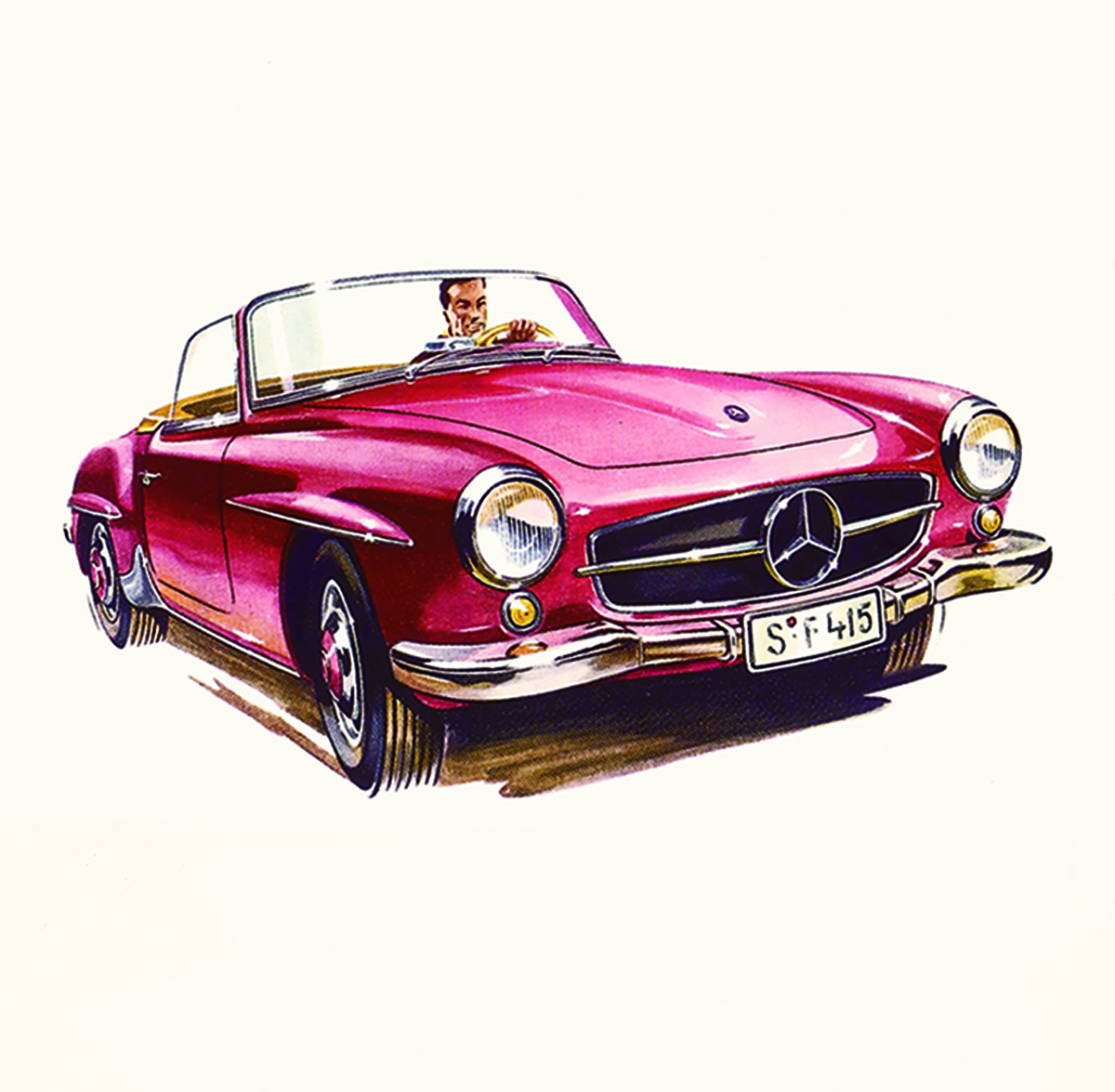 When we look at the 190SL for what it was designed to be, it succeeds in every measure: enduring styling, exceptional engineering, spirited handling – as a sport touring car, not as a racetrack machine – with exceptional comfort on long-distance drives. Those who have owned one for many years have benefited from the 190SL’s recent appreciation in value
When we look at the 190SL for what it was designed to be, it succeeds in every measure: enduring styling, exceptional engineering, spirited handling – as a sport touring car, not as a racetrack machine – with exceptional comfort on long-distance drives. Those who have owned one for many years have benefited from the 190SL’s recent appreciation in value
Elegant & Sporty – W121 190SL • 1955-1963
This handsome two-seater GT is the very definition of postwar style and quality
Article Richards Simonds
Data Tables Daniel Stahl
Images Daimler Archives
When American car importer Max Hoffman’s request to build a customer version of the successful 300SL Gullwing Coupe racecar was approved, he then encouraged the Daimler-Benz Board of Management to create a smaller, less expensive sports touring car to join the 300SL in the burgeoning United States imported-car market. In just five months, the engineers designed and built a prototype to show at the International Motor Sports Show in New York, February 6-14, 1954, as a companion to the Gullwing.
The 190SL used many of the 300SL’s styling cues to associate it with its much more expensive and powerful stablemate. Being much more affordable, the 190SL significantly outsold the 300SL, but it also established a legacy of being compared (often unfavorably) to the iconic 300SL. When we look at the 190SL for what it was designed to be, it succeeds in every measure: enduring styling, exceptional engineering, spirited handling – as a sport touring car, not as a racetrack machine – with exceptional comfort on long-distance drives. Those who have owned one for many years have benefited from the 190SL’s recent appreciation in value.
Reasons to buy a 190SL
Engineering: All major engineered components – engine, transmission, suspension, instruments, etc., are based on the W121 series of sedans, which means drivetrain durability and parts availability from the Mercedes-Benz Classic Center and after-market suppliers.
Drivability: An excellent touring car with compliant suspension, good handling, cushioned seats with good support, better than usual brakes for the time.
Styling: The 190SL has been recognized as a classic design by the Milestone Car Society, and has a familial resemblance to the 300SL, another request from Max Hoffman to Daimler-Benz.
Hardtop/soft top: The hardtop provides coupe-like comfort and quiet driving, while the soft top is well sealed and insulated, making it a good touring car with the soft top up and easy access to top-down driving in good weather.
Reasons not to buy a 190SL
Rust: On any steel-bodied car built before the 1970s, rust is a primary concern. Floor pans, fenders, headlamp boxes, door sills, and subframe mounts for engine and suspension are vulnerable areas that should be inspected carefully.
Poor body repairs: Bad body work is expensive to fix. When 190SLs were just “old cars” and barely worth $2,000, some owners refused to spend more than that to have repairs performed correctly. Finding poor-quality workmanship is common.
Missing trim: Trim for older cars is difficult to find, and correct replacement parts can be expensive or simply not available. Although drivetrain parts and other essential mechanical components are generally obtainable, accent, trim and interior parts are rarely reproduced; be forewarned.
Undercoating: 190SLs, as with other models of this period, were not undercoated at the factory. If you find a car that is undercoated, be certain it is not hiding body rust in all the vulnerable areas.
Carburetors: Solex carburetors get elliptical wear on the body around the throttle shafts, leading to air leaks that affect idling. The bodies are also prone to warping, which means more air leaks and makes it impossible to tune for correct idle and smooth highway running. Sometimes Weber or Mikuni carburetors are substituted for Solex, but that makes them non-original. Rebuilt Solex carburetors, correctly installed and adjusted, are still considered the best choice.
Performance modifications: Owners who wanted more performance often added superchargers; original engines blew up from the resulting stresses that far exceeded the engine’s design parameters. As a result, it was not unusual to find a sedan engine (readily available) replacing the original engine in the 190SL. If numbers-matching is important to you, be sure to check the engine number against the original Daimler-Benz build card.
Checkpoints
All the vulnerable areas should be checked for rust, including the stone guards on the leading edge of the rear fenders. Remove the stone guards and inspect for pinholes.
Undercoating may be hiding rust damage under the car.
Welded seams inside the front inner fenders that were not repaired or welded with original factory precision indicate a poor-quality repair of the nose clip.
Frame-rail rust is one of the most expensive areas to repair and restore. If found, it compromises the safety of the car.
Verify matching factory body numbers on the engine, transmission and rear axle: These are also often found written in grease pencil on body panels, interior trim pieces, etc., during assembly. Numbers should agree with the build sheet to verify the originality of the car.
With the car you are considering to purchase, check for low oil pressure; black, blue, or white smoke from the exhaust; and look for oil and water leaks around the engine. Conduct compression and leak-down tests of the engine to check piston rings, valve guides and seals. Look for black or dirty oil – or oil with white foam, which indicates coolant is mixing with the oil. Check that the brake booster is not leaking brake fluid into the engine through the vacuum cylinder. In other words, due diligence pays off by helping to minimize unpleasant surprises when you get your purchase home.
If the 190SL you are considering has the hardtop option and originality matters, verify it is correct for the year. The rear window was enlarged in 1959.
Buying tips
Values have risen markedly over the past five years, though they have leveled off or dropped recently; there is a risk that less-than-desirable cars will be refreshed cosmetically and sold to unsuspecting buyers who don’t know how to do a due-diligence inspection. Be certain you don’t get a cosmetically pretty disaster.
Take advantage of your contacts in the Mercedes-Benz Club of America and work with someone who is knowledgeable about 190SLs to help you assess the condition of a car that interests you.
For even more specific assistance, consider joining the International 190SL Group and buy the three books Bruce Adams wrote about the 190SL (see resources at left); two of the three volumes cover restoration of the 190SL.
Though it’s based on the W120 sedan chassis, the 190SL was mostly hand assembled; body panels and trim pieces were hand cut to fit precise measurements and panel gaps. Thus, it is important that the car you buy is complete – especially body and trim parts. Otherwise, you will be working with a restoration shop to fabricate parts – by which we mean paying through the nose – for those parts.
Original fitted luggage is a valuable addition to a purchase. If luggage is offered, verify that it is original, not reproduction.
Finally
Based as it was on the 180 Ponton, the 190SL was never designed to be a true sports car, but rather an elegant and sporty two-seater GT. In this role and on its own terms, the 190SL succeeds admirably. A well-sorted 190SL offers discerning enthusiasts an affordable ownership experience and the enjoyment of a classic Mercedes-Benz, engineered with mechanical excellence and positively radiating evocative period style.
190SL Resources
Books
Bruce L. Adams, W121 Coupe & Roadster: A 190SL Touring Sports Car, 2011, ISBN: 978-0-615-44458-1
Bruce L. Adams, Mercedes-Benz 190SL, 1955-1963: Restoration and Ownership, Volume I, 2003, ISBN: 0-9729420-0-9
Bruce L. Adams, Mercedes-Benz 190SL, 1955-1963: Restoration and Ownership, Volume II, 2007, ISBN: 978-0-9729420-1-0
International 190SL Group – www.190slgroup.com
The 190SL Group is an organization of 190SL owners dedicated to the preservation and restoration of the Mercedes-Benz 190SL automobile. Ron Rapp founded the group in August 1983; it now has more than 700 members. The club publishes a bi-monthly newsletter, holds an annual convention and sponsors other events. It has also published two books, assembled a technical manual, produced several videos on the restoration process and developed specialized items for these fine automobiles; these are available for sale from the club store. The International 190SL Group provides access to other 190SL owners and the camaraderie of an active car-enthusiasts club. Membership in the 190SL Group also helps the breed survive.
Chronology
1953 September Daimler-Benz Board of Management approves Max Hoffman’s request to build 190SL
1954 February 190SL shown at International Motor Sports Show, New York (with 300SL coupe)
1955 March Final production version shown at Geneva Motor Show
1955 April First 190SL released from the Sindelfingen production line
1955 July ATE T50 brake booster offered as an option
1955 November Transmission-gear ratios changed
1955 December Eyebrows (chrome strips over wheel arches) now an option for the roadster
1956 January Four-point engine suspension replaces three-point suspension
1956 February Coupe hardtop changed to 0.8mm sheet steel from aluminum
1956 April Coupe folding seats replaced bucket seats; ATE T60 brake booster becomes standard
1956 June Large taillights (such as the 220a and 220S) installed
1957 July License plate lights moved from the body to the bumper guards
1958 May Sun visors with leather covering replace Plexiglas-style sun visors
1958 July Steering lock/ignition switch now standard
1959 October Hardtop with larger rear window installed
1960 August Trunk handle and lock separated into two components
1961 January Fuel tank ventilated; fuel cap no longer ventilated
1961 August M121.928 engine introduced
1963 February W121 190SL Roadster production ends upon introduction of the W113 230SL
Specifications: Mercedes-Benz W121 190SL • 1955-1963
Model 190SL
Years 1955-63
Chassis W121
Engine: 1.9L I-4 OHC
120 Horsepower (SAE Gross)
114 Lb-ft Torque (SAE Gross)
Transmission: 4 speed manual
Rear Axle: 3.7:1 (1955)
3.9:1 1956-1963 (4.1:1 optional)
Zero-62: 13.2-14.5 sec
Top Speed 106
Miles per gallon: 18.8-25
Production Totals
YEARS TOTAL PRODUCTION USA PRODUCTION
1955 1,727 830
1956 4,032 1,849
1957 3,332 1,806
1958 2,722 628
1959 3,949 1,650
1960 3,977 1,264
1961 3,792 1,509
1962 2,246 772
1963 104 54
